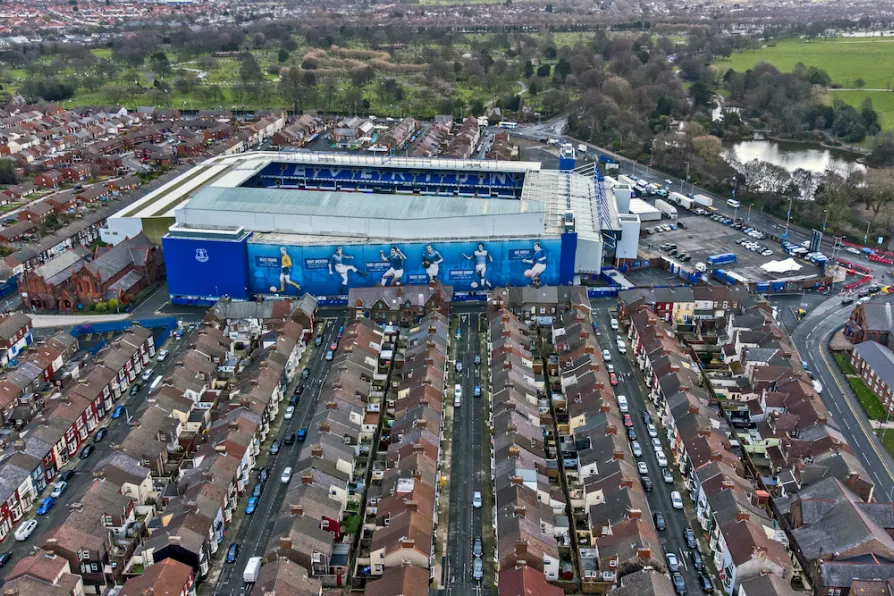
 A general view of Goodison Park, home of Everton Football Club.
A general view of Goodison Park, home of Everton Football Club.
FOOTBALL stadiums are unique arenas where the past combines with the present to produce part of the identity of the team that calls it home.
The same sport is played to pretty much an identical set of laws across the globe, but experiences of watching football in the game’s historic stadiums are rarely replicated.
It is the same game but with different characteristics in different environments producing distinct experiences.
Romanticising about football’s places is often limited to its more exotic theatres. The Bombonera in Buenos Aires. The Azteca in Mexico City. The Maracana in Rio.
But tucked into the terraced streets of Liverpool sits Goodison Park, the home of Everton Football Club, and a stadium with as much charm as any. More than most.
From it, looking across Stanley Park from the modest height of Goodison’s Main Stand, you can see Anfield Stadium, the home of city rivals Liverpool, but originally Everton’s home from 1884 to 1892.
The short distance between the two grounds, and that shared, sometimes turbulent history between the clubs on opposite corners of the park, further adds to the allure of this place as a football place.
If you know it happened, or if you know your history, as Everton fans might say, you can still feel it and sense it. You can’t buy it or remove it.
This is a ground that hosted games at the 1966 World Cup. Some others that witnessed games in that tournament — Roker Park, Ayresome Park, and White City Stadium — have already gone, and sadly Goodison will be next on that list.
Pele played here. Garrincha. Franz Beckenbauer. Eusebio. Lev Yashin. To name a few from that tournament alone.
It has been present as a top-flight venue for so long that most football fans, not just those of Everton, will have some sort of memory of it.
Decades after that World Cup, in a new century with football moved on to a new age, Everton had its own Pele who came from Croxteth to Goodison Park.
Wayne Rooney announced himself in these parts with a wonderful, rumbustious goal against Arsenal, and though he was snapped up by Manchester United after two seasons as a teenager at Goodison, the goal remains one of its magical moments.
On a Thursday night in December 2023, there was a reminder that even a stadium that’s seen it all can still etch new moments of magic into its emotional record.
Everton, ailing financially and sat in the relegation zone with a 10-point deduction recently applied, took on the Saudi-backed Newcastle United—an opponent in rude financial health as a result of that new backing, and one currently participating in the Champions League.
Everton academy product Anthony Gordon lined up for the opposition, while in goal for the Toffees was Washington-born Jordan Pickford, a boyhood fan of and former player at Sunderland, Newcastle’s own local rivals.
It is the kind of moment in which Pickford revels. When it looked like one of his long passes forward was going straight out of play, Newcastle fans cheered sarcastically.
But instead of going out, the ball curled inside the touchline in the direction of Dominic Calvert-Lewin who outmuscled Kieran Trippier and won a free kick right in front of the away fans.
In response to those initial, misplaced taunts, Pickford lifted both hands above his head like a superhero, which he is to the Everton fans inside Goodison. Few enjoyed Everton’s eventual 3-0 win as much as their goalkeeper.
It was the kind of night at Goodison Park that is there to be treasured, as Everton will not call this historic stadium home for much longer.
There is nothing much wrong with it, really. It’s a far better place to watch football than some of the sleek but lifeless containers or adapted athletics arenas that have cropped up in the world of football in recent decades.
It’s old but it still functions for football. But like many urban stadiums embedded into their communities, it has been deemed unable to house the commercial progress required in modern top-level football.
A new facility, one for the modern age to which Everton will move in the coming years, now juts out of Liverpool docks on the banks of the river Mersey.
It is one of the better-looking and more exciting attempts to build a new home for such a storied club.














